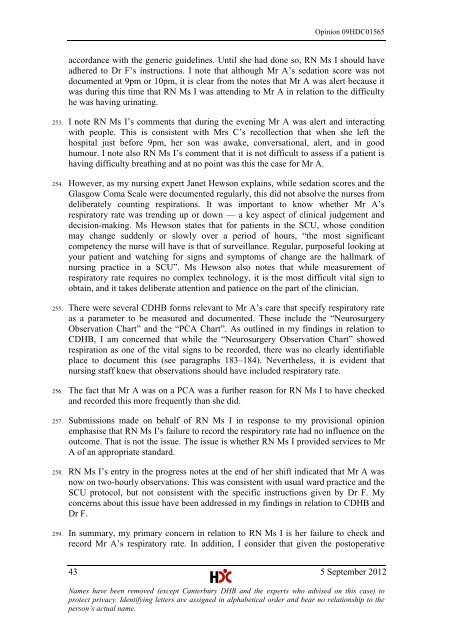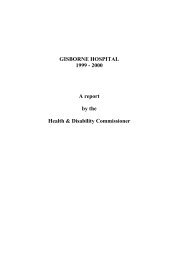09HDC01565 - Health and Disability Commissioner
09HDC01565 - Health and Disability Commissioner
09HDC01565 - Health and Disability Commissioner
Create successful ePaper yourself
Turn your PDF publications into a flip-book with our unique Google optimized e-Paper software.
Opinion <strong>09HDC01565</strong><br />
accordance with the generic guidelines. Until she had done so, RN Ms I should have<br />
adhered to Dr F‘s instructions. I note that although Mr A‘s sedation score was not<br />
documented at 9pm or 10pm, it is clear from the notes that Mr A was alert because it<br />
was during this time that RN Ms I was attending to Mr A in relation to the difficulty<br />
he was having urinating.<br />
253. I note RN Ms I‘s comments that during the evening Mr A was alert <strong>and</strong> interacting<br />
with people. This is consistent with Mrs C‘s recollection that when she left the<br />
hospital just before 9pm, her son was awake, conversational, alert, <strong>and</strong> in good<br />
humour. I note also RN Ms I‘s comment that it is not difficult to assess if a patient is<br />
having difficulty breathing <strong>and</strong> at no point was this the case for Mr A.<br />
254. However, as my nursing expert Janet Hewson explains, while sedation scores <strong>and</strong> the<br />
Glasgow Coma Scale were documented regularly, this did not absolve the nurses from<br />
deliberately counting respirations. It was important to know whether Mr A‘s<br />
respiratory rate was trending up or down — a key aspect of clinical judgement <strong>and</strong><br />
decision-making. Ms Hewson states that for patients in the SCU, whose condition<br />
may change suddenly or slowly over a period of hours, ―the most significant<br />
competency the nurse will have is that of surveillance. Regular, purposeful looking at<br />
your patient <strong>and</strong> watching for signs <strong>and</strong> symptoms of change are the hallmark of<br />
nursing practice in a SCU‖. Ms Hewson also notes that while measurement of<br />
respiratory rate requires no complex technology, it is the most difficult vital sign to<br />
obtain, <strong>and</strong> it takes deliberate attention <strong>and</strong> patience on the part of the clinician.<br />
255. There were several CDHB forms relevant to Mr A‘s care that specify respiratory rate<br />
as a parameter to be measured <strong>and</strong> documented. These include the ―Neurosurgery<br />
Observation Chart‖ <strong>and</strong> the ―PCA Chart‖. As outlined in my findings in relation to<br />
CDHB, I am concerned that while the ―Neurosurgery Observation Chart‖ showed<br />
respiration as one of the vital signs to be recorded, there was no clearly identifiable<br />
place to document this (see paragraphs 183–184). Nevertheless, it is evident that<br />
nursing staff knew that observations should have included respiratory rate.<br />
256. The fact that Mr A was on a PCA was a further reason for RN Ms I to have checked<br />
<strong>and</strong> recorded this more frequently than she did.<br />
257. Submissions made on behalf of RN Ms I in response to my provisional opinion<br />
emphasise that RN Ms I‘s failure to record the respiratory rate had no influence on the<br />
outcome. That is not the issue. The issue is whether RN Ms I provided services to Mr<br />
A of an appropriate st<strong>and</strong>ard.<br />
258. RN Ms I‘s entry in the progress notes at the end of her shift indicated that Mr A was<br />
now on two-hourly observations. This was consistent with usual ward practice <strong>and</strong> the<br />
SCU protocol, but not consistent with the specific instructions given by Dr F. My<br />
concerns about this issue have been addressed in my findings in relation to CDHB <strong>and</strong><br />
Dr F.<br />
259. In summary, my primary concern in relation to RN Ms I is her failure to check <strong>and</strong><br />
record Mr A‘s respiratory rate. In addition, I consider that given the postoperative<br />
43 5 September 2012<br />
Names have been removed (except Canterbury DHB <strong>and</strong> the experts who advised on this case) to<br />
protect privacy. Identifying letters are assigned in alphabetical order <strong>and</strong> bear no relationship to the<br />
person’s actual name.
















